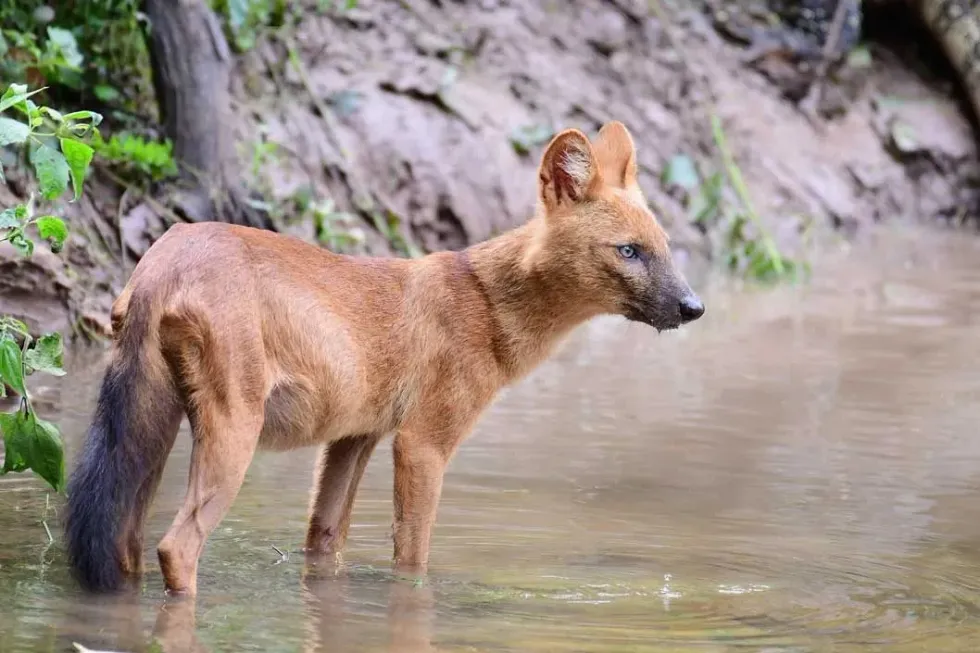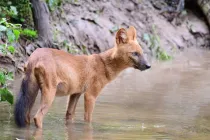Dholes might look like a dog or a wolf, but their genetics differ a lot. They are a highly skilled and elusive jumper that is classified into the taxonomic family of Canidae and are classified with coyotes, foxes, jackals, and wolves.
However, they don’t fit with any of the subfamilies and are, therefore, classified in a genus of their own, known as Cuon.
They only have two molars instead of three on either side of their lower jaw. Also, compared to their doggie counterparts, they have a shorter jaw as well. However, female dholes have a higher number of teats than any other canid species and are capable of producing 12 pups in a litter.
Dholes are also incredibly athletic animals. They are excellent swimmers, impressive jumpers, and fast runners. All these skills come in handy when they are out in a pack, hunting a prey.
In certain protected areas, they even share the habitat with leopards and tigers. Also, these animals are known to be extremely vocal, especially while hunting. Since they are a part of the dog family, whining and growling, like the popular family pet, is expected.
However, there is a series of screams and clucking noise that is unique to these animals. No other canine makes this type of sound while hunting a prey. Dholes can also communicate with one another while hunting their prey through chattering and whistling.
Unlike other canids, dholes do not display fighting behavior. In fact, it is even difficult to find out which one is the dominant pair of male-female dhole in the pack.
When the young pups or young adult animals reach maturity, they are even free to work with other packs without facing any trouble.
The pack of dholes works together as a unit to rear their pups until they are old enough to select their own pack. However, there is not a lot of research on dhole and it is because of this that this endangered species that likes hunting is suffering and now there aren't enough dhole conservation opportunities.
If you find this article fascinating, you may also check out our animal fact files on pocket pitbull and lab chow mix.
Dhole Interesting Facts
What type of animal is a dhole?
Also known as the whistling dog, the red dog, or the Asiatic wild dog, the dhole species is a jumper that looks like a long-legged fox but is the same size as the German shepherd.
What class of animal does a dhole belong to?
The dhole is a mammal who is known to be a highly skilled and elusive jumper that likes to hunt. They are a part of the taxonomic family of Canidae and are classified with coyotes, foxes, wolves, and jackals.
How many dholes are there in the world?
There are only 2,500 dholes left in the world. Even though their number is less than tigers, they are ignored by the global public, researchers, and conservationists. That is why some people call them the forgotten predator.
Where does a dhole live?
Dhole species is found in Southern and Eastern Asia, from the Malay Peninsula in the south to Siberia in the north.
What is the dhole's habitat?
Dholes can be found in a wide range of habitats and climates including alpine regions, steppes, scrub, and dense forests.
Who do dholes live with?
Just like other dogs, the dhole species lives in a group known as packs. They are a social species that wag their tails happily at one another while greeting.
The dhole packs also work together for feeding and caring for the group. Each pack can have somewhere between 5-12 members. However, the members can also also be found playing or working with dholes from another pack.
How long does a dhole live?
The maximum longevity for the endangered dhole dog is 15-16 years.
How do they reproduce?
The dhole are endangered predators commonly found in Asia known to breed between November and December. During this season, the male dhole will spend about two weeks courting the female and another two weeks mating with her.
Only one dominant pair of the dhole packs breeds with one another. The rest of the pack is responsible for assisting in caring for the pups and the mother.
For the dhole, the gestation period is two months, after which a litter of 5-12 pups is birthed by the mother. The mother has 16 teats for feeding the pups and young members.
At just a few months of age, the dhole pups will be ready for joining the hunt. Since they are young, the dhole packs even let them eat first after a successful kill.
This will last until they are one year old, which is the age where they are completely grown. These little members of the pack reach sexual maturity when they are three years old.
At this time, females leave the pack. This is an unusual trait that isn’t seen in most pack animals.
What is their conservation status?
According to the International Union for Conservation of Nature, the dhole predators population is under the ‘endangered’ species category.
Dhole Fun Facts
What do dholes look like?
The color of a dhole depends on the habitat they are living in and might vary from rusty red to charcoal grey to sandy beige. Their tail is fox-like and brushy and, in most cases, has a black tip.
Living in the wild, these wild dogs have a white chest, belly, and feet. However, they might not always have the same features. An adult dhole will have rounded ears and a long tail.
Just like most dog species, they are also really good at adapting to their surroundings. Also, male dholes are heavier and larger than females.
How cute are they?
Since dholes or the Indian wild dog resemble dogs, many consider them cute animals.
How do they communicate?
For communicating with one another, the Asiatic wild dog (Indian wild dog predators) use distinct sounds that are not associated with the sounds made by the domestic dogs that are commonly known. When pack members of the dholes team up to attack their prey, they create a sound, ‘kaka-kaka’.
This almost sounds like a bird screeching. They also use other sounds such as ‘coo-coo’ or wild dog whistling for communicating with one another. This is also the reason why they are known as ‘whistling dogs’.
How big is a dhole?
Since the endangered dholes or Cuon Alpinus mainly found in Asia are only 12-20 kilograms in weight, their size is 30-50% the size of an average wolf. This means that they are even smaller than several medium-sized dogs.
How fast can a dhole run?
The top speed of a dhole or Cuon Alpinus is 65 km/hr.
How much does a dhole weigh?
The average weight of a large hunting dhole or red dog is somewhere between 12-20 kg.
What are their male and female names of the species?
There are no specific names for males and females of this species.
What would you call a baby Dhole?
A baby dhole will be called a pup.
What do they eat?
Large dholes’ primary food involves mammals or prey species including deer, wild goats, buffalo, and wild pigs. In southeast Asia, they feed on banteng, gaur, and deer. In Siberia, their diet includes deer, reindeer, and wild sheep. They are also known to eat rabbits, lizards, bugs, and berries.
The pack members can also hunt on their own. At an animal park, they are usually fed a ground meat diet specially created for zoo carnivores. This includes bones that they can chew on.
Are they slobbery?
Yes, hunting dholes are known for their slobbery nature.
Would they make a good pet?
Compared to wolves, dholes are easier to domesticate. If they are captured as pups, it is possible to make them quite tame.
Historically speaking, people dwelling in the forest would enter the range of the dhole and drive off with its kills and have the meat for themselves.
This is because it was a well-known fact that even large dholes are not aggressive and won’t defend their food. Since they could be so easily tamed and had a passive nature, Brian Houghton Hodgson, the British ethnologist and naturalist believed that the Canis primaevus or the dhole was actually the domestic dog’s ancestor.
He claimed that their head was similar to the one of a domestic dog.
But, if you look at the teeth of the dhole, they appear extremely different from a dog species. Hodgson used to keep dholes as pets and found that they can be trained just like a domestic dog.
Did you know...
There are several organizations in the world that have been trying to help dholes (Cuon Alpinus). For example, biologists working at the Minnesota zoo partnered with the Smithsonian Conservation Biology Institute to help the dhole population currently living in Thailand. They are collecting basic information regarding how dholes evaluate current threats and use their habitat.
They are also working on a management plan for the Asiatic wild dog (Indian wild dog) living in the wild. The first step of this management plan is finding elusive and shy dholes in the forest.
Dr. Kate Jenks, a conservation biologist at Minnesota Zoo uses camera traps for tracking the location of wild animals including dholes.
The team has also been placing GPS tracking collars on dholes who are from different packs. These collars fitted on the neck of the wild dogs collect data that helps the scientists in learning how the dhole population use different types of habitat, where they travel, and whether they roam near the areas where dogs live.
When the dhole animal and dogs meet, it can lead to the spread of diseases which is extremely dangerous for the mountain wolf dog since they are already a small population.
If they catch a disease, their population could crash. Through the data recorded by the collars, the scientists are also estimating the population of packs living in the area and outlining home ranges for them.
How to pronounce dhole?
Here is the pronunciation for the word ‘dhole’. It is one syllable: "DOHL". In Traditional IPA it is dəʊl and in Modern IPA, it is də́wl.
How many dholes are left in the world?
The population of dholes, the predatory animal, is only 2,500 in the world who are currently residing in protected areas. Their habitat has been destroyed for making room for farming and their main diet, deer, has been killed by poachers.
Their population has decreased so much that there are more tiger in the wild than dholes. Large and small dhole populations face the same threats as other wild canid species such as wolves.
In some countries, people blame them for killing their livestock and then kill them. Sometimes, they also get sick from dogs that haven’t been vaccinated.
Here at Kidadl, we have carefully created lots of interesting family-friendly animal facts for everyone to discover! Learn more about some other mammals including pitbull chihuahua mix, or cheagle.
You can even occupy yourself at home by drawing one on our dhole coloring pages.










